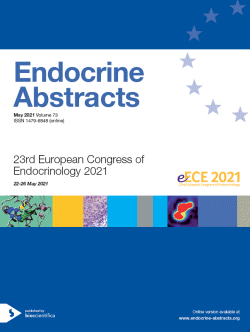
European Congress of Endocrinology 2021
Online
22 May 2021 - 26 May 2021
Presented Eposters
Presented ePosters 13: Pituitary and Neuroendocrinology
ea0073pep13.1 | Presented ePosters 13: Pituitary and Neuroendocrinology | ECE2021
Factors associated with Aryl hydrocarbon Interacting Protein (AIP) expression in gonadotroph pituitary neuroendocrine tumours (Pit-NETs)
Polidoro Michela A. , Feola Tiziana , Gianno Francesca , Palumbo Valeria , Arcella Antonietta , Morace Roberta , De Angelis Michelangelo , Giangaspero Felice , Esposito Vincenzo , Jaffrain-Rea Marie-Lise
ea0073pep13.2 | Presented ePosters 13: Pituitary and Neuroendocrinology | ECE2021
Use of free triiodothyronine level in central hypothyroidism management
Bouzegaoui Nacera El , Ornella Raad , Marion Soyez , Abdallah Al Salameh , Rachel Desailloud
ea0073pep13.3 | Presented ePosters 13: Pituitary and Neuroendocrinology | ECE2021
Natural history of nonfunctioning pituitary incidentalomas and adenomas. A systematic review and meta-analysis
Dukanovic Stefan , Andreassen Mikkel , Krogh Jesper
ea0073pep13.4 | Presented ePosters 13: Pituitary and Neuroendocrinology | ECE2021
Long term management in aggressive thyrotropinoma
Stanca Oana , Stancu Cristina , Dumitrascu Anda , Badiu Corin
ea0073pep13.5 | Presented ePosters 13: Pituitary and Neuroendocrinology | ECE2021
Cushing’s syndrome and chronotype
Albani Adriana , Zopp Stephanie , Simon Julia , Vogel Frederick , Reincke Martin , Merrow Martha , Theodoropoulou Marily
ea0073pep13.6 | Presented ePosters 13: Pituitary and Neuroendocrinology | ECE2021
Improved acromegaly patient satisfaction with oral octreotide capsules compared with injectable somatostatin receptor ligands in the MPOWERED trial
Gordon Murray B , Fleseriu Maria , Dreval Alexander V , Pokramovich Yulia , Bondar Irina , Isaeva Elena , Molitch Mark E , Macut Djuro P , Leonova Nina , Raverot Gerald , Kirschner Lawrence S , Chanson Philippe , Yossi Gilgun-Sherki , Ludlam William H , Patou Gary , Haviv Asi , Biermasz Nienke , Melmed Shlomo K , Christian J Strasburger
ea0073pep13.7 | Presented ePosters 13: Pituitary and Neuroendocrinology | ECE2021
Hepcidin is lower in patients with acromegaly compared to healthy control subjects
Filipowicz Dorota , Krygier Aleksandra , Ewelina Szczepanek-Parulska , Domagalska Maja , Ruchala Marek
ea0073pep13.8 | Presented ePosters 13: Pituitary and Neuroendocrinology | ECE2021
Use of antisense oligonucleotides as a therapy for Cushing’s disease
Kemp Elizabeth , Eltumi Hanan , Whatmore Jacob , John Newell-Price



